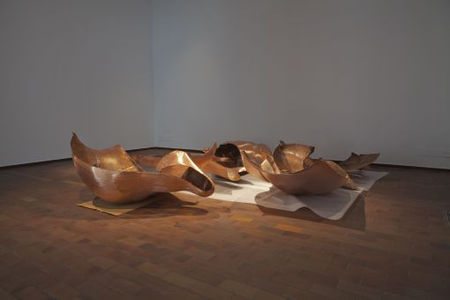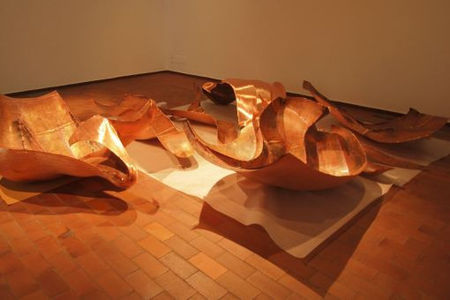Danh Vo, JULY, IV, MDCCLXXVI @ Kunsthalle Fridericianum
Danh Vo, We the People. Photo: Nils_Klinger.
With JULY, IV, MDCCLXXVI, Danh Vo shifts the focus of his artistic investigations to the concept of freedom. The title designates 4 July 1776, the date of the signing of the U.S. Declaration of Independence from Great Britain. The writing in Roman numerals is taken from the tablet that the figure of New York’s Statue of Liberty is holding in her left hand. Since 1886, Miss Liberty has symbolized the hope of a better life for refugees and immigrants arriving in New York. She is the most important emblem of freedom and independence, which Danh Vo absorbs. Based on the dimensions of the original and its copper weight of some 31 tons, Vo had a replica of the Statue of Liberty made which forms the main part of JULY, IV, MDCCLXXVI. He calls the gigantic sculpture WE THE PEOPLE, reciting the first three words of the preamble to the United States’ Constitution of 17 September 1787. But the monumentality of the statue is immediately qualified: the sculpture is dissected into its individual parts and thus abstracted. In his recreation, Vo concentrates on reproducing the thin copper skin (the iron scaffolding supporting the figure is missing), which gives WE THE PEOPLE a special fragility. The broken icon, the destroyed allegorical figure of Libertas, forms a strong counterpoint to the massive materiality.
Danh Vo, We the People. Photo: Nils_Klinger.
The confrontation with physical mass contrasts with a spatial openness in the ground floor, where Danh Vo steers attention to a striking found piece: the original typewriter on which Theodore Kaczynski wrote the Unabomber’s Manifesto. Kaczynski, a university professor and terrorist, who carried out bomb attacks in the USA for 18 years, waged a personal battle against so-called leftism, industrial society and its belief in progress. In 1995 he anonymously sent a manifesto, a detailed, pseudo-philosophical critique of civilization entitled Industrial Society and its Future, to the New York Times and the Washington Post. In the text he offered to stop the attacks if the newspapers published his manifesto. Shortly after the text appeared, Kacyznski was found in a small cabin in the mountains of Montana and arrested. Recently this cabin as well as its contents were auctioned by the FBI.
Danh Vo, WE THE PEOPLE (detail), 2011. Installation view at Fundació Joan Miró. Courtesy of the artist and Galerie Chantal Croussel, Paris. Photo: Pere Pratdesaba. Fundació Joan Miró, Barcelona
Exhibiting objects based on the ready-made principle is a characteristic artistic strategy of Danh Vo. The objects Vo selects are multilayered bearers of meaning which he uses to tell stories and disclose relationships. They always contain a complex political and poetic system with which the artist perceptively links art and life. The exhibition in Kassel also involves a widely branching narrative strand, which, starting from the concept of freedom, explores failed political, social and personal aims, takes up issues of self-determination and responsibility, and extends the definition of guilt and innocence.
On occasion of the exhibition an edition will be published.
Danh Vo, WE THE PEOPLE (detail), 2011. Installation view at Fundació Joan Miró. Courtesy of the artist and Galerie Chantal Croussel, Paris. Photo: Pere Pratdesaba. Fundació Joan Miró, Barcelona
Danh Vo, WE THE PEOPLE, 2011 (detail)
Danh Vo, WE THE PEOPLE, 2011 (detail)

/https%3A%2F%2Fprofilepics.canalblog.com%2Fprofilepics%2F1%2F0%2F100183.jpg)
/https%3A%2F%2Fstorage.canalblog.com%2F03%2F02%2F119589%2F96711876_o.jpg)
/https%3A%2F%2Fstorage.canalblog.com%2F11%2F31%2F119589%2F94773502_o.jpg)
/https%3A%2F%2Fstorage.canalblog.com%2F20%2F83%2F119589%2F94772815_o.jpg)
/https%3A%2F%2Fstorage.canalblog.com%2F26%2F72%2F119589%2F75604929_o.jpg)
/https%3A%2F%2Fstorage.canalblog.com%2F59%2F60%2F119589%2F26458628_o.jpg)








/http%3A%2F%2Fstorage.canalblog.com%2F49%2F32%2F119589%2F121218630_o.jpg)
/http%3A%2F%2Fstorage.canalblog.com%2F13%2F52%2F119589%2F111410133_o.jpg)
/http%3A%2F%2Fstorage.canalblog.com%2F45%2F49%2F577050%2F40122976_p.jpg)
/image%2F1371349%2F20240426%2Fob_dcd32f_telechargement-32.jpg)